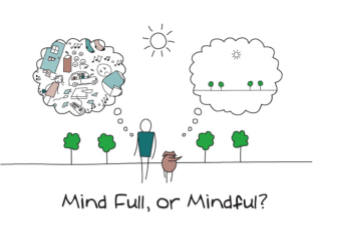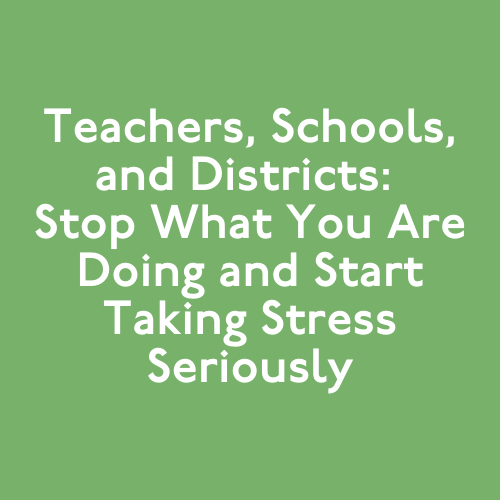Stress. Secondary Traumatic Stress (STS). This isn’t a millennial problem, a caregiver or teacher problem, a new or “silly” problem. Since the beginning of time, human’s have been biologically wired to get stressed. Stress can initiate the “fight or flight” response, a complex reaction of neurologic and endocrinologic systems” (Medicine Net). As cavemen and women, our stress response were useful systems of responding to problems and safety threats – we either fought or fled, then it was over. Nowadays, our stress response systems are engaged more frequently and for longer periods of time. Also, through increased communication and diverse roles, there are more opportunities for secondary stress and traumas.

This is part one of a three-part series aimed to bring awareness and solutions surrounding STS in order to live happier, healthier, safer lives that promote positive decision-making, healthy relationships, and equitable, creative, safe, and supportive learning environments. The series will help explain the:
-
Definition of secondary traumatic stress (STS);
-
Warning signs of STS in ourselves and others;
-
Impact of STS in ourselves and others;
-
Proactive self-care strategies for preventing or mitigating STS; and
-
Reactive strategies for addressing STS in ourselves and others.
What is Secondary Stress?
The National Center on Safe Supportive Learning Environments reports:
“Secondary traumatic stress (STS) is the emotional distress that results when an individual hears about the traumatic experiences of another individual. Distress may result from hearing someone’s trauma stories, seeing high levels of distress in the aftermath of a traumatic event, needing to retell a student’s story, and/or seeing photos or images related to the trauma. Individuals with symptoms severe enough could be diagnosed with post-traumatic stress disorder (PTSD).”
Anyone can experience primary or secondary stress and traumas. Colleagues, friends, family, and community members are no exception to secondary stress as well, as it does not need to be – though often is – linked to a job. “In a growing number of professions, including firefighters, law enforcement, trauma doctors and nurses, child welfare workers, and therapists and case managers, it is now understood that working with people in trauma — hearing their stories of hardship and supporting their recovery — has far-reaching emotional effect on the provider” (J. Lander, 2018). Many teachers are experiencing secondary traumatic stress through vicarious experiences with students and other community members. School and district leaders are also experiencing similar trends and negative impacts of primary and secondary stress. One study, by the American Institue for Policy Development, highlights the correlation between superintendent stress levels and their overall health. Effective teaching and leading is negatively impacted and strained when we are experiencing primary and secondary stress. While the secondary stress might seem easy to ignore in the moment, as the direct incident did not happen to you, your body cannot ignore it. There are many warning signs to tell you that you are experiencing primary or secondary traumatic stress, despite any attempts to ignore it.
What are the Warning Signs?
The warning signs and impact of secondary stress can range from mild to debilitating, and impact all areas of your life and body.
Trauma Aware Schools outlines secondary stress warning signs as:

-
“Emotional: feeling numb or detached; feeling overwhelmed or maybe even hopeless.
-
Physical: having low energy or feeling fatigued.
-
Behavioral: changing your routine or engaging in self-destructive coping mechanisms.
-
Professional: experiencing low performance of job tasks and responsibilities; feeling low job morale.
-
Cognitive: experiencing confusion, diminished concentration, and difficulty with decision making; experiencing trauma imagery, which is seeing events over and over again.
-
Spiritual: questioning the meaning of life or lacking self-satisfaction.
-
Interpersonal: physically withdrawing or becoming emotionally unavailable to your co-workers or your family.”
The National Center on Family Homelessness also adds feeling guilty about spending time away from work, struggling to take downtime or vacation, decreased social life, and persistent difficulty getting restful or enough sleep.
What is the Impact of Secondary Stress?
The potential impact of secondary trauma can surpass the mild to very serious impacts of the warning signs outlined in the previous section. “Secondary exposure to trauma has also been associated with the burnout dimensions of emotional exhaustion, depersonalization and reduced levels of personal accomplishment (e.g., Craig & Sprang, 2010). Emotional exhaustion is characterized by a lack of energy, and feeling that one’s emotional resources are depleted.” (Australian Psychological Society, 2015). The American Psychological Association (APA) outlines the negative effects of stress on our body, including our poor and inconsistent eating and workout habits.
Just as secondary stress can impact all parts of our bodies, it can impact all parts of our lives, including our classrooms, schools, and communities. Stress effects classroom climate and teacher burnout. EdWeek published a stress impact on schools overview, reporting:
“Those who showed higher levels of stress at the beginning of the year displayed fewer effective teaching strategies over the rest of the school year, including clear instruction, effective classroom management, and creation of a safe and stimulating classroom climate for their students, than did the teachers with lower initial stress levels” (2017)
A 2017 study goes on to show the correlation between teacher stress, burnout, coping, self-efficacy to student outcomes, including disruptive behaviors and academic achievement.
Why do Schools and Districts Need to Prioritize Support for Stress and STS?

Stress and secondary stress is not just limited to adults, and can directly or indirectly impact all ages and members of the school community. Secondary stress in schools and districts are often related to taking on the secondary trauma of the students and community members. Teachers and leaders are left feeling guilt and overwhelmed feeling they aren’t doing enough, and that there is a constant need to give even more back to the classroom/school/district.
For example, in October 2018, the APA published it’s 12th annual stress in America report on Generation Z. There are nearly 74 million individuals in Gen Z in the United States, born between 1995 and 2015. Findings included evidence of primary and secondary traumas related to high-profile traumatic news reports:“ sexual harassment and gun violence, are significant stressors for Gen Z”. The APA predicts they are the “most likely of all generations to report poor mental health” and seek professional help. This is a generational trend and prediction for students nationwide. Consequently, if nationwide students are more likely to experience primary stress or trauma, then teachers and educators are more likely to experience the impacts of secondary traumatic stress from hearing about and witnessing the student’s stress.
Negative effects of primary and secondary stress are already being seen among educators nationwide. The 2017 Educator Quality of Work Life Survey, published by the American Federation of Teachers, provides shocking insights into stress and secondary stress among educators nationwide. Over half of the teachers surveyed reported their mental health as “not good.” 61% of educators and school staff reported that they find their work “always” or “often” stressful. Classrooms, schools, and districts nationwide need to help all community members address primary and secondary stress in order for effective teaching and learning to occur.
What are Strategies for Addressing STS?
Schools and districts must prioritize mental health supports for self, staff, students, and the larger community. However, it is hard to support others and make a systemic change if you are just surviving instead of thriving. The rest of this three-part series will focus on strategies for addressing secondary traumatic stress in ourselves as adults working in a school or districts, and supporting our colleagues.
Don’t wait to get started: here are some resources that will give you strategies on addressing secondary traumatic stress and incorporating trauma-sensitive practices in your school or district. The National Child Traumatic Stress Network provides an in-depth look at types of traumas, impact, and related resources. The Harvard Graduate School of Education provides a great overview of the impact of STS in our schools and provides some trauma-informed strategies for implementation (J. Lander, 2018).
Sign up for Move This World’s newsletter to stay up to date on social emotional learning.
Enter your email below










